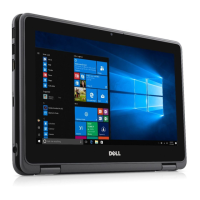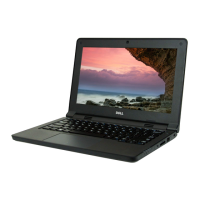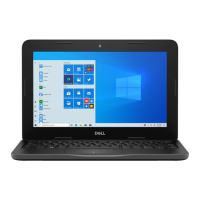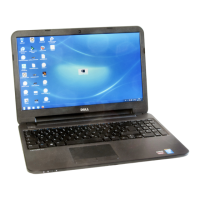Do you have a question about the Dell Latitude 3180 and is the answer not in the manual?
Provides essential safety guidelines to protect users and prevent equipment damage during operation.
Details the procedure for safely shutting down the computer using the Windows 10 operating system.
Outlines necessary preparation steps, including safety checks and workspace setup, before accessing internal components.
Lists the essential tools required for performing component removal and installation procedures accurately.
Instructions for removing and installing the microSD card from its slot on the computer.
Procedure for safely removing and reinstalling the computer's base cover for access to internal components.
Steps for removing and installing the computer's battery, noting it as an optional component.
Guidance on how to remove and install the computer's keyboard assembly.
Instructions for removing and installing the M.2 Solid State Drive (SSD) from the system.
Procedure for removing and installing the computer's audio board.
Steps for removing and installing the computer's power connector port.
Instructions for removing and installing the coin cell battery.
Procedure for removing and installing the computer's speaker components.
Detailed steps for removing and installing the main system board of the computer.
Procedure for removing and installing the computer's display assembly.
Instructions for removing and installing the display bezel.
Steps for removing and installing the computer's display panel.
Procedure for removing and installing the computer's display hinges.
Instructions for removing and installing the computer's camera module.
Information about the laptop's power adapter specifications and handling.
Details on the processors available for the laptop, including model and specifications.
Guide to checking processor usage and performance using the Windows Task Manager.
Instructions for monitoring processor performance and usage via the Windows Resource Monitor.
Information on the chipsets used in the computer, specifically the Intel 100 Series.
Details on the Intel HD Graphics chipsets supported by the computer.
Specifications related to the computer's memory, including type and speed.
Steps to check system memory details and configuration within the BIOS setup.
Procedure for running the Enhanced Pre-Boot System Assessment (ePSA) to test system memory.
Information on the graphics chipset options available for the laptop.
Details on the supported hard drive types and capacities for the laptop.
Guide to locating and identifying the installed hard drive within the BIOS settings.
Overview of Universal Serial Bus (USB) technology and its evolution.
Explanation of USB 3.0/3.1 Gen 1 features, speed, and technical advancements over USB 2.0.
Discusses the applications and benefits of USB 3.0/3.1 Gen 1 technology.
Information on the compatibility of USB 3.0/3.1 Gen 1 with different operating systems and prior versions.
Introduction to HDMI 1.4 technology and its features for audio/video interface.
Details on specific features of HDMI 1.4, including Ethernet Channel and 4K support.
Highlights the benefits of using HDMI, such as quality and cable reduction.
Information on the integrated Realtek ALC3246 High Definition audio codec.
Details on the front-facing camera specifications, including resolution.
Explanation of the one-time boot menu accessed via F12, including available options.
Describes the keys used for navigating within the System Setup (BIOS) utility.
Provides a general overview of what can be done using the System Setup utility.
Step-by-step instructions on how to enter and access the System Setup (BIOS) utility.
Details the primary hardware features and system information available in the BIOS General screen.
Information on configuring system hardware options, such as SATA drives, within the BIOS.
Details on setting video-related options, such as LCD brightness, in the BIOS.
Options for setting and managing passwords (Admin, System, HDD) in the BIOS Security screen.
Configuration options for enabling or disabling the Secure Boot feature in the BIOS.
BIOS settings for optimizing computer performance, including Multi-Core Support.
Settings for managing the computer's power consumption and wake-up behaviors.
BIOS options that control the system's behavior during the Power-On Self-Test (POST).
Settings for enabling or disabling internal wireless devices like WLAN and Bluetooth.
Detailed specifications for the computer's memory modules.
Options for viewing and clearing system logs and events within the BIOS.
Configuration options for the SupportAssist System Resolution feature.
Instructions for updating the computer's BIOS from within the Windows operating system.
Information on creating and managing system and setup passwords for BIOS security.
Key specifications of the computer's system, including chipset and bus details.
Technical details about the processors installed in the computer.
Detailed specifications for the computer's memory modules.
Details regarding the types and capacities of storage devices supported by the computer.
Specifications for the computer's integrated audio controller and features.
Technical details about the computer's video capabilities and GPU.
Specifications for the computer's built-in camera, including resolution.
Details on the computer's wireless communication features, like WLAN and Bluetooth.
Information on the various ports and connectors available on the computer.
Specifications related to the computer's keyboard, such as the number of keys.
Details on the computer's touchpad, including active area dimensions.
Technical details about the computer's battery, including type, capacity, and temperature range.
Specifications for the AC adapter, including input voltage and output current.
Dimensions and weight of the computer.
Details on the operating and storage conditions for temperature and humidity.
Overview of the ePSA diagnostics tool for checking hardware integrity before OS loading.
Step-by-step guide on how to initiate and run diagnostic tests using ePSA.
Procedure for resetting the Real Time Clock (RTC) to resolve system startup issues.
| Form factor | Clamshell |
|---|---|
| Product type | Laptop |
| Product color | Black |
| Market positioning | Educational |
| Tjunction | 105 °C |
| Processor cache | 2 MB |
| Processor cores | 4 |
| System bus rate | - GT/s |
| Processor family | Intel® Pentium® |
| Processor series | Intel Pentium Processor N4000 Series for Mobile |
| Processor socket | BGA 1296 |
| Processor codename | Apollo Lake |
| Processor frequency | 1.1 GHz |
| Processor cache type | L2 |
| Processor lithography | 14 nm |
| Processor manufacturer | Intel |
| PCI Express slots version | 2.0 |
| Processor boost frequency | 2.5 GHz |
| Processor operating modes | 64-bit |
| ECC supported by processor | No |
| PCI Express configurations | 1x2, 1x2+2x1 |
| Thermal Design Power (TDP) | 6 W |
| Scenario Design Power (SDP) | 4 W |
| Maximum number of PCI Express lanes | 6 |
| Internal memory | 4 GB |
| Memory clock speed | 1600 MHz |
| Memory form factor | On-board |
| Internal memory type | LPDDR3-SDRAM |
| AC adapter included | Yes |
| SSD capacity | The Solid State Drive's storage capacity in Gigabytes. |
| SSD interface | SATA |
| Storage media | SSD |
| SSD form factor | M.2 |
| Total storage capacity | 128 GB |
| Compatible memory cards | SD |
| Number of SSDs installed | 1 |
| Display diagonal | 11.6 \ |
| Display resolution | 1366 x 768 pixels |
| Native aspect ratio | 16:9 |
| Number of execution units | 18 |
| On-board graphics card ID | 0x5A84 |
| Discrete graphics card model | Not available |
| On-board graphics card model | Intel® HD Graphics 505 |
| Maximum on-board graphics card memory | 8 GB |
| On-board graphics card base frequency | 200 MHz |
| On-board graphics card burst frequency | 750 MHz |
| Audio chip | Realtek ALC3246 |
| Speaker power | 2 W |
| Number of built-in speakers | 2 |
| Front camera resolution | 1280 x 720 pixels |
| Front camera resolution (numeric) | 1 MP |
| Wi-Fi standards | 802.11a, Wi-Fi 5 (802.11ac), 802.11b, 802.11g, Wi-Fi 4 (802.11n) |
| Bluetooth version | 4.2 |
| HDMI version | 1.4 |
| Docking connector | - |
| Charging port type | DC-in jack |
| USB 2.0 ports quantity | 0 |
| Pointing device | Touchpad |
| Trial software | McAfee, Microsoft Office |
| Battery capacity | 42 Wh |
| Number of battery cells | 3 |
| Cable lock slot type | Noble |
| Operating altitude | 0 - 3048 m |
| Non-operating altitude | 0 - 10668 m |
| Storage temperature (T-T) | -40 - 65 °C |
| Operating temperature (T-T) | 0 - 35 °C |
| Storage relative humidity (H-H) | 5 - 95 % |
| Operating relative humidity (H-H) | 10 - 90 % |
| Processor ARK ID | 95592 |
| Processor package size | 24 x 31 mm |
| Intel Identity Protection Technology version | 1.00 |
| Intel Small Business Advantage (SBA) version | 0.00 |
| Sustainability certificates | ENERGY STAR |
| AC adapter frequency | 50 - 60 Hz |
| AC adapter input voltage | 100 - 240 V |
| Depth | 206 mm |
|---|---|
| Width | 303.3 mm |
| Height | 20.75 mm |
| Weight | 1260 g |











